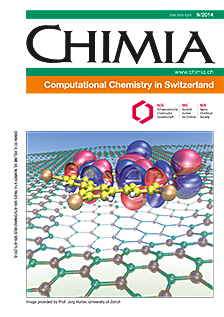Non-uniform Continuum Model for Solvated Species Based on Frozen-Density Embedding Theory: The Study Case of Solvatochromism of Coumarin 153
DOI:
https://doi.org/10.2533/chimia.2014.609Keywords:
Continuum models, Density functional theory, Multi-level simulations, Orbital-free embedding theory, SolvatochromismAbstract
Recent application of the Frozen-Density Embedding Theory based continuum model of the solvent, which is used for calculating solvatochromic shifts in the UV/Vis range, are reviewed. In this model, the solvent is represented as a non-uniform continuum taking into account both the statistical nature of the solvent and specific solute–solvent interactions. It offers, therefore, a computationally attractive alternative to methods in which the solvent is described at atomistic level. The evaluation of the solvatochromic shift involves only two calculations of excitation energy instead of at least hundreds needed to account for inhomogeneous broadening. The present review provides a detailed graphical analysis of the key quantities of this model: the average charge density of the solvent (<?B>) and the corresponding Frozen-Density Embedding Theory derived embedding potential for coumarin 153.Downloads
Published
2014-09-24
How to Cite
[1]
S. V. Shedge, X. Zhou, T. A. Wesolowski, Chimia 2014, 68, 609, DOI: 10.2533/chimia.2014.609.
Issue
Section
Scientific Articles
License
Copyright (c) 2014 Swiss Chemical Society

This work is licensed under a Creative Commons Attribution-NonCommercial 4.0 International License.







